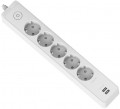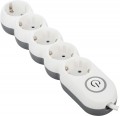Product type
The general features of the design and application of the network filter depend on the type.
—
Extension lead. Traditional extension cords designed to bring power to devices located far from outlets, as well as to increase the number of sockets themselves. They do not have built-in filters and provide almost no protection. On the other hand, such devices are extremely simple and inexpensive.
—
Cable reel. Extension cords in which the wire is wound on a spool. They are significantly longer than models without coils; in addition, the user can adjust the length of the wire at his discretion. On the other hand, the weight and dimensions of such devices are also quite significant. As a result, extension cords on a reel are not well suited for home use, but may be indispensable for some specific tasks. For example, using such a device, you can stretch power through the yard of a private house, for work in a garage or a barn.
—
H-frame extension lead. Extension cords in which the wire is wound around the frame — a special holder that resembles a double-sided horn. The design of the frame itself allows you to conveniently unwind and wind the power cord, while the wire is not subjected to twisting into knots and tangles. The extension cord on the frame usually has only one socket for connecting an electric current consumer.
— Roulette ex
...tension lead. A kind of extension cord with a round body, in which the cord is wound in the manner as it is implemented in construction roulettes. In its upper part there are sockets (their number and type may differ), and on the reverse side there is a handle for returning the cord to the case. There is no automatic winding of the cord on the coil inside the case.
— Surge protected adapter. The simplest type of network filters are compact devices that are attached directly to the outlet. The possibilities of such devices are extremely simple: other connectors, in addition to ordinary sockets, are extremely rare in them, and the sockets themselves are usually provided with less than one (although exceptions are possible). On the other hand, small size in some situations can be an important advantage. In addition, such a filter can be constantly worn on the plug of the device with which it is used.
— Surge protector. Devices that combine the functions of a surge protector and an extension cord: allow you to connect electrical appliances to the network that are remote from outlets, while smoothing out the interference that occurs on the network. In addition, most models have several outlets, which allows you to connect several devices to one such filter at once. Note that models with 3-5 outlets are very popular as a means of connecting desktop PCs to a network: they allow you to power both the system unit and peripherals (monitor, speakers, printer, etc.) and additional devices like a table lamp from one outlet .
— Surge protector reel. Network filters equipped with a wire reel. According to the features of the application, they are completely similar to the extension cords on the reel described above, adjusted for the fact that in this case the device not only works as a remote outlet, but also protects the load from interference in the network.Max. power
The highest power consumption of the connected devices that the surge protector can tolerate without consequences (to be more precise, with which it can work indefinitely without overloads, overheating, etc.).
This limitation is due to the fact that the higher the power at the same voltage, the higher the current passing through the equipment (in this case, through the surge protector); and off-design currents can lead to breakdowns and even accidents. And although in order to avoid these consequences, modern filters often provide various types of protection (see above), however, the operation of protection is still an emergency situation that is best avoided. Therefore, it is worth choosing a model according to this parameter in such a way that the maximum filter power is at least not lower than the total power consumption of the load. And it is best to have a margin of 20 – 30% — this will give additional guarantees in case of various deviations in the operation of the connected equipment.
Separately, it is worth highlighting the situations when the filter is planned to be used for the so-called reactive load — electrical appliances that widely use circuits on capacitors and/or inductors, for example, power tools or refrigeration units. The total power consumption of such devices (written in volt-amperes) can be much higher than the active power (which is indicated in watts). The recommended line filter power in such cases is calculated using special...formulas that can be found in the relevant sources.
Wire section
The cross-sectional area of the wire used to connect the filter to the network. The larger the cross-sectional area, the thicker the wire, the more reliable it is and the more current it can pass without overheating. Accordingly, thick wires (
1.5 mm² and
2.5 mm²) are a must for high power devices. At the same time, modern manufacturers, usually, choose the cross-sectional area in such a way as to guarantee the safe operation of the filter at the claimed maximum power (see above). Therefore, in fact, a model with a thicker cable than other similar devices should be chosen if it is supposed to be used in unstable networks in which power surges often occur. If the cross-sectional area seems too small for you (
0.75 mm² or
1 mm²) for the claimed power, there are special formulas that allow you to check the validity of such doubts.
USB A
The number of
USB ports for charging, provided in the design of the surge protector.
Such ports do not perform any other function than powering and charging external devices such as smartphones or tablets. The presence of such connectors in the surge protector can be especially convenient when there is no “230-to-USB” adapter at hand, and there are few USB ports in a computer or laptop and using them for charging is “an unaffordable luxury”.
Max. charging current
The current output by a USB connector when a charging gadget is connected to it.
The higher the current, the faster the battery can charge. However, when choosing, note that in order to use a high current strength, the connected device must also support it. Basically there are
USB with a current strength of 2.1 A,
2.4 A and
3 A.
It is also worth noting that when using several USB ports at the same time, the current strength is significantly reduced.
Power (with 1 device)
The maximum power that a USB port can produce when connecting only one gadget.
Higher power output speeds up the charging process. At the same time, there are a number of nuances associated with this parameter. Firstly, the appropriate power must be supported not only by the port, but also by the gadget being charged - otherwise the speed of the process will be limited by the characteristics of the gadget. Secondly, to take full advantage of the capabilities, you may need to support not only the appropriate charging power, but also a specific fast charging technology. Thirdly, in filters with several charging connectors, the maximum power per device can only be achieved if the other ports are not used.
Protection
—
Short circuit protection. Short circuit (short circuit) protection system — situations when the impedance in the circuit drops sharply, for example, due to a metal object falling between the socket contacts. It reacts to a sharp increase in current and opens the circuit, allowing you to avoid damage and fire equipment.
—
Voltage drops protection. Protection against power surges in the network. A filter with this function is able to completely cut off power that exceeds the allowable rate set by the manufacturer, protecting the load from damage. Note that the surge protector is not able to replace a full-fledged stabilizer or voltage relay; however, in more or less high-quality networks that are not subject to strong fluctuations, a filter is quite enough.
—
Overload protection. In this case, overload means a situation when the load power exceeds the values \u200b\u200ballowed for a given network filter. This situation is similar to the short circuit described above — high currents go through the filter; however, overload has its own specifics, so protection against it can be provided as a separate system. However, the principle of operation of such systems is classic: when the permissible power is exceeded, it turns off the power, preventing breakdowns and fires.
—
Varistor protection. A kind of protectio
...n against short-term power surges in the network, built on varistors — variable impedance resistors. The impedance of such a resistor under normal conditions is in the millions of ohms, but it drops sharply if the input voltage increases above a certain value. Due to this, in normal mode, the protection practically does not affect the circuit, and with a high-voltage pulse, excess energy “merges” through the varistor and dissipates in the form of heat. The ability of varistors to absorb energy is not infinite, therefore, to protect against overheating, the design usually provides for a temperature sensor with an automatic switch.Wall mount
Availability
of fastening on a wall in a network filter design. Such fastening most often has the form of a characteristic eyelet (loops), designed to be put on a nail driven into the wall or other similar detail. And the installation on the wall itself is convenient in that the filter can be quite close to the user, and besides, it does not take up space on the floor (which, among other things, minimizes the risk of stepping on the device, damaging it during cleaning, etc.) .

